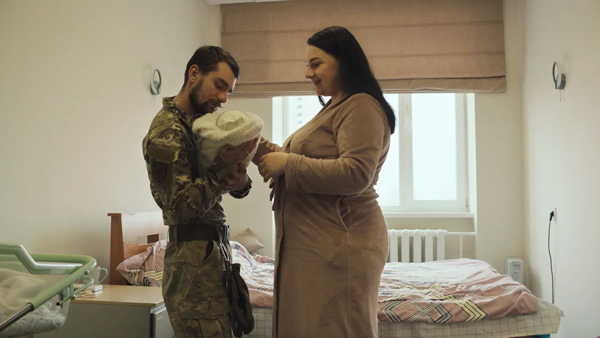Life During Wartime: Loznitsa’s Gaze Blankets Ukraine
 Director Sergei Loznitsa continues as the ultimate contemporary chronicler of Ukraine’s past and present, his latest, the aptly titled The Invasion, highlighting lives of citizens over the past two years of war with Russia. Described as a diptych in its accompaniment with Loznitsa’s 2014 documentary Maidan, which captured footage of the civil unrest in Maidan Square across 2013 and 2014 (now playing like a prologue in retrospect), it’s in keeping with his favored style of austere observation. In essence, life must go on for those living beneath Russia’s sword of Damocles, but it also has irrevocably informed traditions, rituals, and all ways of life in ways which may perhaps only seem most discernible in hindsight.
Director Sergei Loznitsa continues as the ultimate contemporary chronicler of Ukraine’s past and present, his latest, the aptly titled The Invasion, highlighting lives of citizens over the past two years of war with Russia. Described as a diptych in its accompaniment with Loznitsa’s 2014 documentary Maidan, which captured footage of the civil unrest in Maidan Square across 2013 and 2014 (now playing like a prologue in retrospect), it’s in keeping with his favored style of austere observation. In essence, life must go on for those living beneath Russia’s sword of Damocles, but it also has irrevocably informed traditions, rituals, and all ways of life in ways which may perhaps only seem most discernible in hindsight.
Appropriately, The Invasion opens with a mass funeral, snatches of a eulogy anointing an all-too familiar reality. But it’s followed by several soldiers marrying their brides, an occasion which seems pared down to the barest of necessities. There’s only time to really honor the dead, while the living have to seize their moments quickly. Loznitsa begins to drift in and out of various scenarios, and a majority of his subjects are somehow processing their current realities. There aren’t many moments of outright conflict or bitterness, sans an early moment when someone is being questioned if they’re Russian or Ukrainian at a local water supply.

Shot over two years, it’s striking to see what’s likely shifted, both in an immediate response to Russia’s invasion, and with those directly confronted by the horrors of the frontlines. Silently, a group of men and women painstakingly pack up Russian literature, where Tolstoy, Dostoevsky and Nabokov are pruned from shelves, stacked in piles, tossed into trucks. Air raid strikes sound, and sometimes there’s a weariness about the response.
Medical workers tend to those needing attention, and women give birth. But for all these expected life moments, The Invasion finds Loznitsa including more moments of dialogue than we’re accustomed to, and these tend to be the most arresting sequences. A woman serving as a volunteer worker shares the experiences of her husband, a soldier who was badly tortured and she hopes will return in an upcoming exchange of prisoners on Christmas or New Year’s. She reflects on the years it will take him to overcome this trauma, even though he’s also a mental health professional.
Likewise, an elderly elementary school teacher asks her children to reflect on art she’s kept from her previous students. A common theme between past and present emerges amongst these paintings which focus on either war or peace, reality or wish fulfillment. She engages her children in unpacking these thoughts as they create their own art for the day. Later, we observe a solitary woman working slowly and quietly through a pile of rubble, stacking bricks into a pattern, highlighting the constant reconstruction despite the crumbling reality around them. Finally, outdoor memorials for the fallen, which have taken on their own kind of power as an artistic exhibition of resiliency, caps Loznitsa’s film, a mother mourning with her two daughters. Her children turn their backs to the camera as she gazes at the ground. Perhaps one invasion necessitates another in an effort to document, understand, and deliberate.
Reviewed on May 16th at the 2024 Cannes Film Festival – Special Screenings. 145 Mins.
★★★/☆☆☆☆☆


